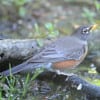 By Jim Stevenson
By Jim Stevenson
1- In the future, because many hundreds of you have purchased my book on the Bird-life of Galveston, I will be making reference to page numbers in my gallery for anyone wishing further information or study. It will be preceded by “BoG” but will be non-distracting.
2- I got chewed out by someone for not scheduling any day trips in late April, in the heart of the bird migration, and their point was well taken. So…I’m having Wednesday morning shorebird/songbird trips on the West End for a bargain $25. Jokes included. We’ll meet in the middle of the parking lot at the light in Pirate’s Beach at 8 am, where our friends and supporters Sand n Sea do business. Done around noon. These will be April 16, 23 and 30, plus May 7.
Your Gallery will be in two parts this week, both songbirds. Today’s is before Sunday, and Wednesday’s will be from the fallout Sunday on. The gallery will be birds you might see at Feather-fest, so be excited!
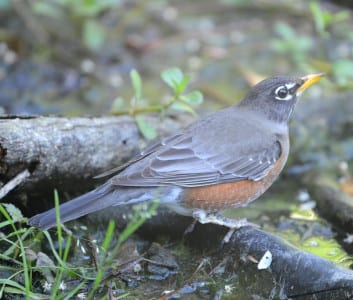
We have scattered flocks of robins around all winter, but a few arriving off the gulf well into the spring. And third, some nest from La Marque into the neighborhoods of Houston. The above is a male, with females a bit paler and less colorful. To understand the different statuses of birds, read from 124 to 125.
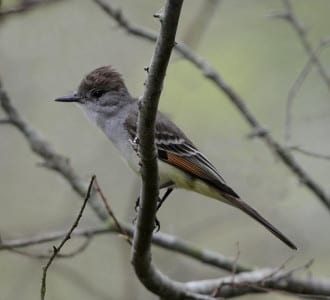
Ash-throated Flycatchers range across South Texas, as close as San Bernard NWR in Brazoria County. This one was there last week and was fairly tame. They are much less yellow underneath than great-crests, and have less contrast between the gray chest and yellow belly. They’re also a bit smaller.
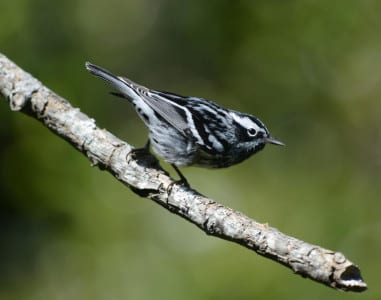
Black-and-white warblers are here for the entire spring migration, but are especially common in late March and early April. They creep around on the bark and probe into crevices. This is a male, with a black throat.
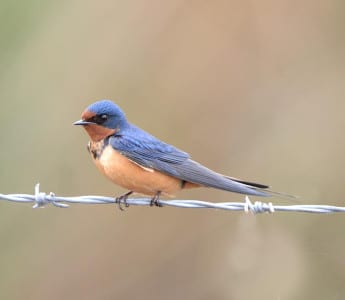
Swallows are streaming by, heading up the coastline SW to NE, as circum-Gulf migrants. You can see rough-wings, Banks, Cliffs and Trees, but these Barn Swallows are always our most abundant bird. They also nest in eaves of buildings, such as at GISP and the Stingaree Restaurant on Bolivar (with great seafood!).
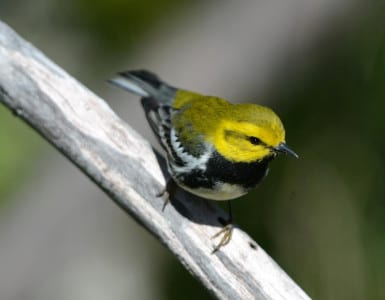
Black-throated Green Warblers are also seen throughout much of the migration, with the males being quite the lookers. Some ask about Golden-cheeked Warblers, but that species is virtually unknown on the UTC.
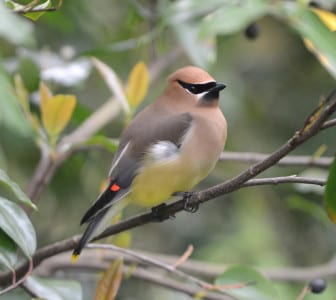
Cedar Waxwings winter in the Deep South and are departing quickly for more northern nesting grounds. However, later in the migration, ones that wintered in places like the Yucatan will cross the Gulf and show up here, even as late as early May.
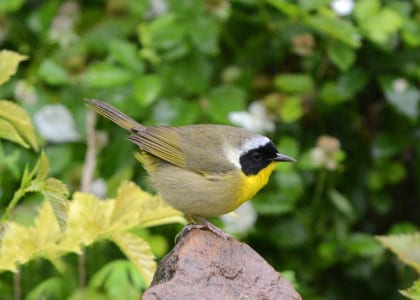
Common Yellowthroats creep up out of the marshes and sneak through woods for bugs at this time. Males are unmistakable with their black masks, but make sure you know the difference between them and Hooded & Kentucky.
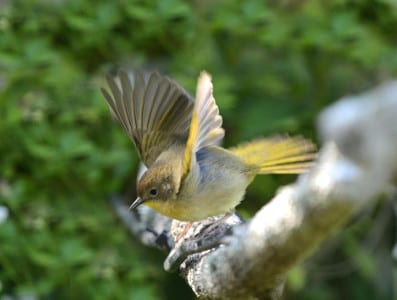
Female yellowthroats are tougher, but notice the yellow on the throat. This will separate them from Mourning, Nashville, Orange-crowned and any other (rather) similar warblers. This species also makes a distinct “chack” note often heard in marshes, etc. One of the unexpected joys of bird photography is hitting the shutter at exactly the right moment – often by accident – to get something like a “wings-up” shot. Many hints about this are found on page 136.
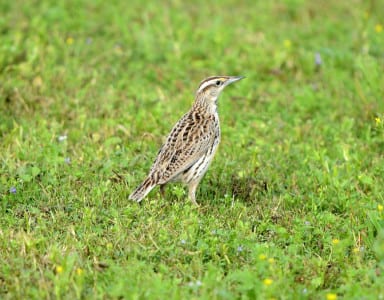
Eastern Phoebes winter in big numbers in our area but have just about left. This makes it easier to ID the early pewees that drop in. The bad news is, you have to tell the Eastern from Western Wood-pewees, as records of the latter are accumulating. Later this spring, you’ll also have to deal with various Empidonax flycatchers, starting with Acadian. Good luck on that. 😉
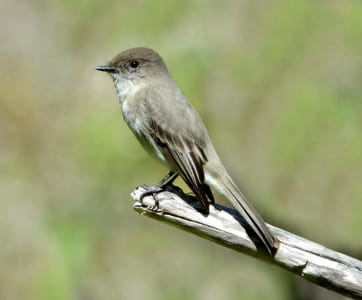
Eastern Phoebes winter in big numbers in our area but have just about left. This makes it easier to ID the early pewees that drop in. The bad news is, you have to tell the Eastern from Western Wood-pewees, as records of the latter are accumulating. Later this spring, you’ll also have to deal with various Empidonax flycatchers, starting with Acadian. Good luck on that. 😉
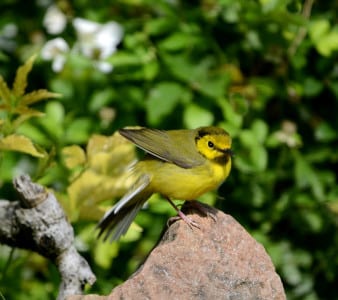
An interesting sidelight to birding in early spring is the changing plumages we see, when they morph from either winter or immature plumage into breeding, adult garb. This is a male Hooded Warbler, gaining his black hood.
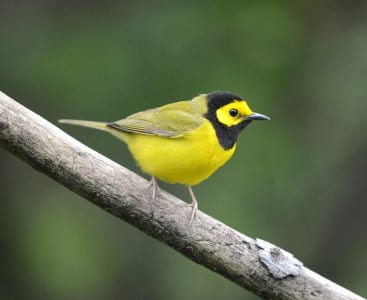
Fully-developed Hooded Warblers are quite showy, and tame as well. This has also been a terrific year for them the last three weeks, as places like Laffite’s (and my yard!) have been loaded. Plus, very few females have gotten here yet, so it’s gonna be a banner year for them!
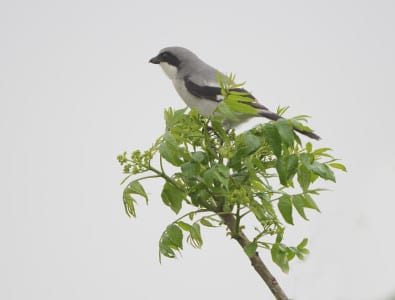
Not a big friend to the warblers are the Loggerhead Shrikes. They will catch small birds and rats and pin them on barbed wire fences. Shrikes are nesting right now and often quite near parking lots, etc. This one is in the State Park, nesting in the Hercules Club.
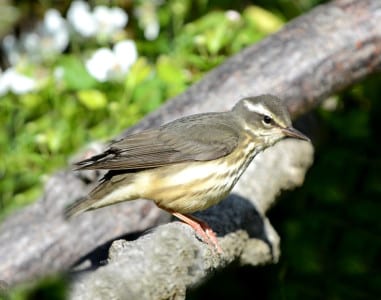
It’s still early in the migration and Louisiana Waterthrushes may still be seen. They are carefully identified by their beige sides, p ink legs and white eyestripe that gets wider behind the eye. Tougher differences include the unstreaked throat and the larger beak.
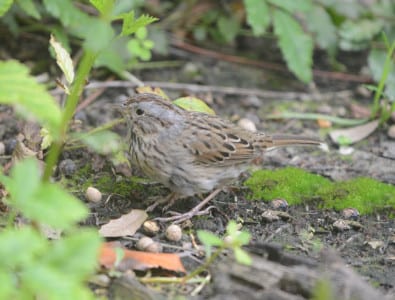
Lincoln Sparrows are winter residents on the UTC but they become more common and conspicuous around this time, plus the males start singing. Note the buffy streaks on the chest, a unique field mark that no other species has and is only found on this species. 😉 Department of redundancy department.
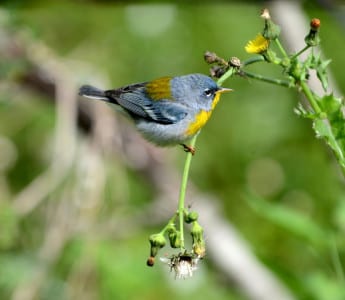
We are well over halfway through our allotment of Northern Parulas, but a few persist. They are unmistakable with their blue top and yellow front, and the green middle of the back is typical parula. This is a small, short-tailed warbler of the southern swamps, but they live in the canopy and are much easier to see in the migration.
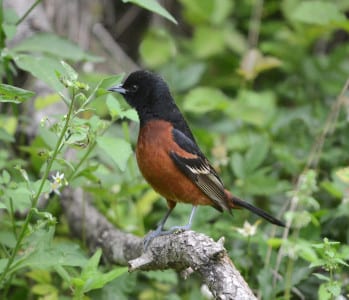
Orchard Orioles are very common ear ly spring migrants, although they persist throughout most of the period. They are now even nesting sparingly on Galveston, ever-increasing. They and Indigo Buntings are faring well with forest fragmentation, while most of their ilk is struggling.
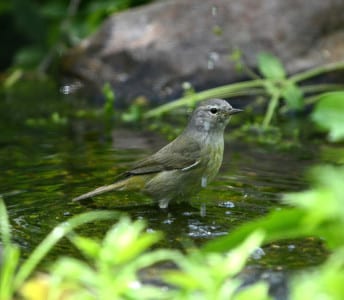
Orange-crowned Warblers are winter residents but our birds are joined by others from further south in early April, all headed north. They are “kinda gray” up front and “kinda greenish” in the aft, but the best field mark is the white feather on the bend of the wing. Do you see it? They also have a bill that’s a bit conical, used for taking small fruit in the winter. This is why “myrtles” have the large beak they possess.
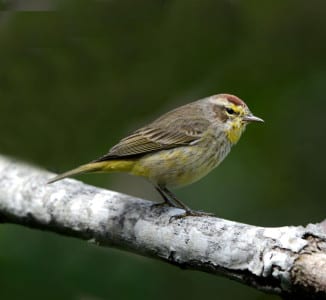
In places like Anahuac NWR, breeding plumage Palm Warblers may be seen at this time
(along with White-crowned and Song Sparrows). These Palms, and the rare (in Texas) Prairie, bob their tails incessantly. Seems like I also saw Kirkland’s doing that in Michigan way back when. Palms winter in Indian Beach but they never look like that! This is a Western Palm Warbler, but there is also a Northern (Yellow) Palm Warbler. Are they the same species and how can you tell? To understand this, read 114-115. This species is found most commonly at Dos Vacas, on page 141, but also Indian Beach.
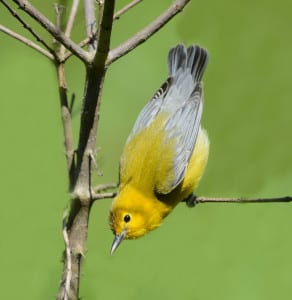
This is the Prothonotary Warbler, and it’s only a female! The short tail and unbarred wings help ID it, but there’s no mistaking that golden front. Their bill is large, like a Swainson’s, to probe into crevices in large trees along the great southern rivers, p lus they’re deadly with that area’s spiders. This species nests abundantly at Brazos Bend State Park, near the middle of the Figure-8 walk, so see page 142.
![Flycatchers eat a lot more berries and fruit than most people think, coz it gives them sugar for their migration. [They’re not on Atkin’s like me!] Being great fliers, they can pluck off what they want easily, without clambering around on limbs. The Scissor-tailed Flycatcher is common at FF time, with a few even nesting on the UTC.](https://www.crystalbeachlocalnews.com/wp-content/uploads/2014/04/FF-Songbirds21-394x300.jpg)
Flycatchers eat a lot more berries and fruit than most people think, coz it gives them sugar for their migration. [They’re not on Atkin’s like me!] Being great fliers, they can pluck off what they want easily, without clambering around on limbs. The Scissor-tailed Flycatcher is common at FF time, with a few even nesting on the UTC.
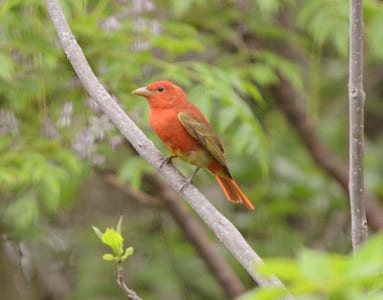
This Summer Tanager showed up a few days ago and doesn’t want to leave my yard. The odd colors identify him as a first-year male, now molting from the immature plumage of the first winter into the permanent red feathers. Oddly, Scarlet Tanager males molt into greenish-yellow winter plumage every year.
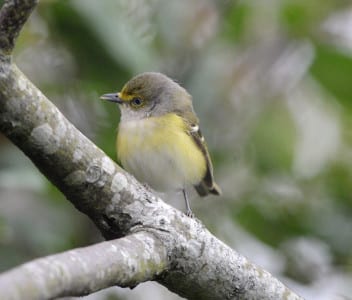
White-eyed Vireos are common in March and early April, nesting in scrubby land along the UTC. If you look at the head of this bird you can see the hooked, cylindrical bill of the vireos (flycatchers are flatter) and the white iris of this species. It also has wingbars, which few vireos possess.
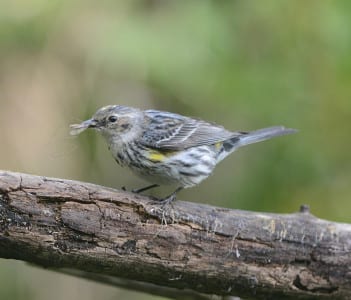
I suspect this is also a changing male Yellow-rumped, but it’s a bit behind the last bird. It has a Crane Fly in its bill, which seems to be far more legs than body! Around FF you can see a male YRWA look many ways, although females are usually your basic brown.
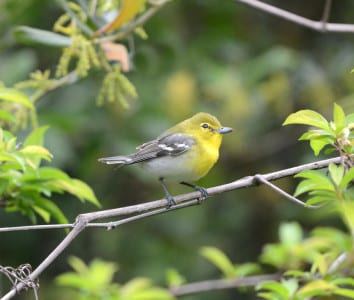
The only vireo with any real color is the Yellow-throated Vireo. Conspicuous is the vireo bill, cylindrical and hooked, and wingbars behind the yellow front. These are southern in range, so they are early migrants.
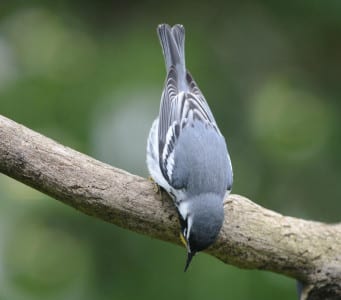
Hiding on the bark is the lovely Yellow-throated Warbler, with only the name being confused with the previous species. Like most FF birds, these are southern breeders, and most actually migrate through in March! Where’s the yellow?
![Oh. These beautiful birds are another bark feeder with a long bill, and the race in West Florida (Westoni?) [Bruce, help me!] has an extra special long bill. They are quite rare the rest of the migration. These birds look quite different from other eastern birds, but are rather similar to the Grace’s Warbler of the Desert Southwest’s canyons.](https://www.crystalbeachlocalnews.com/wp-content/uploads/2014/04/FF-Songbirds28-363x300.jpg)
Oh. These beautiful birds are another bark feeder with a long bill, and the race in West Florida (Westoni?) [Bruce, help me!] has an extra special long bill. They are quite rare the rest of the migration. These birds look quite different from other eastern birds, but are rather similar to the Grace’s Warbler of the Desert Southwest’s canyons.

 Posted in
Posted in 
























Hi there Yahoo operates good but your site is loading steadily which actually had taken just about one minute to actually load up, I am not sure if
it’s my personal issue or perhaps your site problems.
Nevertheless, Thank you for posting such a beautiful articles.
I’m sure this has been incredibly helpful individual who actually visit here.
I personally must point out that you really have done amazing work with
this as well as hope to find many more awesome stuff through you.
To obtain additional information by articles that
you write-up, I’ve saved to my bookmarks this
web site.
Hey there! Your site is loading slow for my situation, the site
consumed like a moment to finally load up, I actually dont know if
it is just me or your web-site then again facebook loaded fine
for me. However , I appreciate you for writing wonderful article.
Perhaps this has become necessary to many people .
I personally should mention that you actually have done wonderful work with this
and additionally wish to find even more great stuff from you.
To obtain more knowledge through posts you publish, I actually have added this url.
I got this web page from my friend who shared with me regarding
this web page and at the moment this time I
am browsing this site and reading very informative content at
this time.
I read this article completely concerning the difference of newest and preceding technologies, it’s remarkable article.